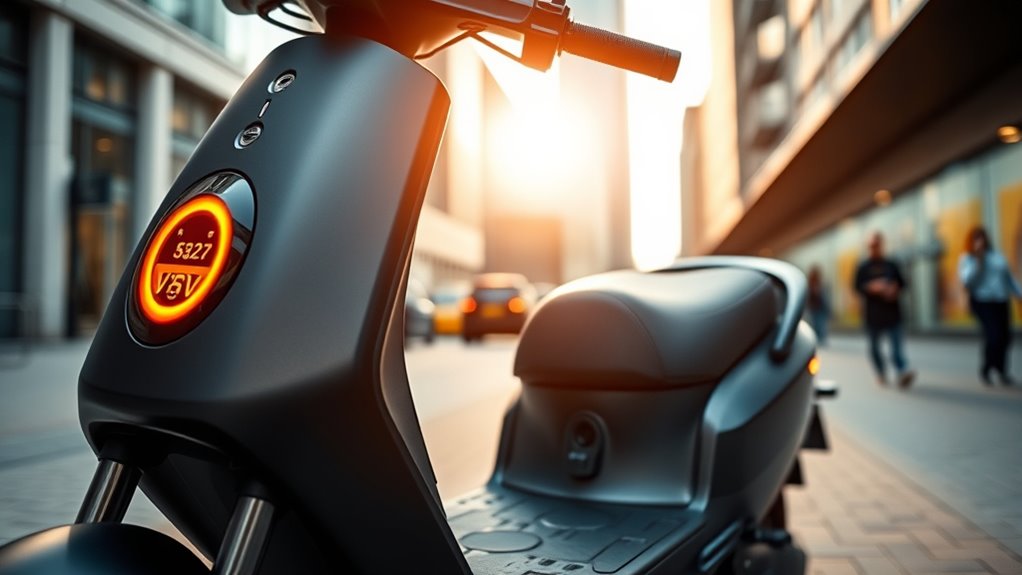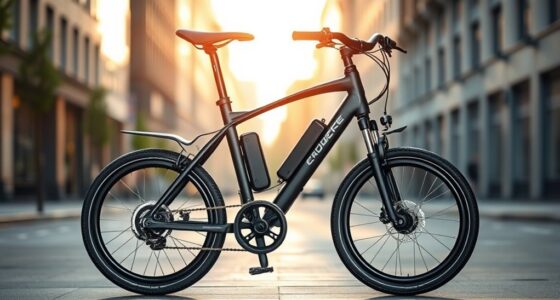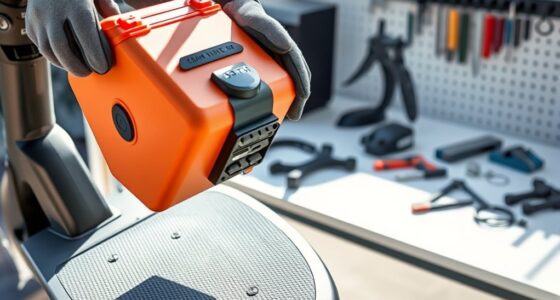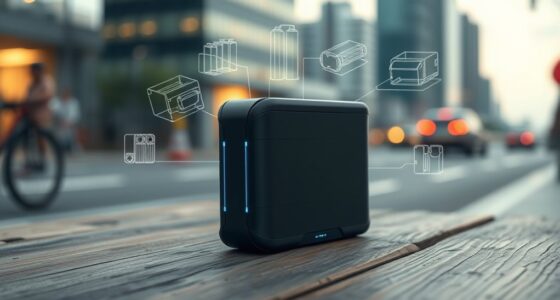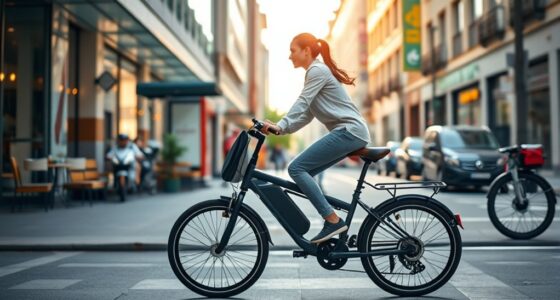Understanding voltage and power in electric scooters helps you choose the right model for your needs. Higher voltage means more speed and better acceleration, while increased power output improves overall performance. Balance these features with battery capacity and motor efficiency to guarantee longer rides and improved efficiency. If you want to know how these factors work together and impact your ride, there’s more to discover about optimizing your electric scooter’s performance.
Key Takeaways
- Voltage indicates the electrical potential and influences the scooter’s speed, acceleration, and power delivery.
- Higher voltage systems generally enable increased motor power, speed, and better performance.
- Power output, measured in watts, combines voltage and current to show the scooter’s overall power capacity.
- Proper balance between voltage and capacity ensures optimal performance and ride range.
- Understanding these factors helps in selecting a scooter that matches your speed, range, and riding needs.

Electric scooters are becoming increasingly popular for urban commuting, but understanding how they work can be confusing. When you’re looking at different models, one of the most important things to *evaluate* is how voltage and power influence your ride. These factors directly impact your scooter’s performance, range, and overall efficiency. To start, you need to grasp how battery capacity and motor efficiency play into this equation. Battery capacity, usually measured in watt-hours (Wh) or amp-hours (Ah), tells you how much energy your scooter’s battery can store. A larger capacity generally means a longer ride before needing a recharge, but it also affects the weight and size of the scooter.
Understanding battery capacity and motor efficiency helps optimize your electric scooter’s performance and range.
Motor efficiency is another critical aspect, as it determines how effectively the scooter converts electrical energy from the battery into mechanical energy to move you forward. A highly efficient motor wastes less energy, meaning you get more mileage out of the same battery capacity. When you understand this, you realize that a scooter with a powerful motor isn’t necessarily better if it’s not efficient. For example, a motor with high efficiency can deliver the same performance as a less efficient one but consume less power, extending your range.
Voltage plays a *crucial* role here because it influences the motor’s power output. Most electric scooters operate within a certain voltage range, often between 24V and 52V. Higher voltage systems can deliver more power, allowing for faster acceleration and higher top speeds. However, simply choosing a higher voltage isn’t the whole story. You need to *assess* how the battery’s capacity and the motor’s efficiency work together. If you have a high-voltage system but a low-capacity battery, your scooter might still run out of juice quickly. Conversely, a large battery with a lower voltage may provide a decent range but won’t necessarily deliver the same speed or torque.
In essence, understanding voltage and power in electric scooters isn’t just about knowing numbers; it’s about seeing how those numbers relate to each other. A well-balanced combination of battery capacity, motor efficiency, and voltage will give you a scooter that’s not only fast and powerful but also capable of lasting longer on each charge. When shopping for your scooter, pay attention to these key factors. Knowing how they work together helps you choose a model that matches your riding needs, whether it’s quick city commutes or longer journeys across town.
Frequently Asked Questions
How Does Temperature Affect Scooter Battery Performance?
Temperature greatly impacts your scooter battery’s performance. When it gets too hot or cold, you may notice reduced range and power. Excess heat accelerates battery degradation, shortening its lifespan, while cold temperatures can limit capacity. Proper thermal management helps keep the battery within an ideal temperature range, maintaining performance and longevity. By controlling temperature, you ensure your scooter runs smoothly and your battery lasts longer.
Can Voltage Variations Impact Motor Lifespan?
Voltage variations can substantially impact your scooter’s motor lifespan. When voltage isn’t stable, the motor experiences fluctuating power levels, which can cause undue stress and wear over time. Maintaining voltage stability ensures your motor operates smoothly, enhancing its durability. If voltage drops or spikes occur frequently, it might reduce motor durability, leading to potential early failure. Always keep an eye on voltage consistency to prolong your scooter’s motor lifespan.
What Safety Precautions Are Needed for High-Voltage Scooters?
A stitch in time saves nine, so think safety first. When riding high-voltage scooters, you should check that your battery insulation is intact and avoid exposing it to water or extreme heat. Always guarantee proper voltage regulation to prevent overloads. Wear protective gear, follow manufacturer instructions, and keep the scooter well-maintained. These precautions help you stay safe and keep your ride smooth and reliable.
How Do Power Ratings Influence Acceleration?
Power ratings directly affect your scooter’s acceleration by providing more motor torque and better performance. A higher power rating means your scooter can deliver greater force, resulting in quicker starts and faster speeds. When the battery capacity supports this increased power, you’ll experience smoother acceleration. So, if you want snappier acceleration, look for a scooter with a higher power rating, ensuring it has enough battery capacity to handle the demands on the motor.
Are There Differences in Voltage Standards Internationally?
You might wonder if voltage standards vary worldwide. Yes, they do, which impacts international compatibility of electric scooters. Different countries use different voltage standards, like 110V or 220V, affecting charging and operation. When choosing a scooter for international travel, check the voltage standards in your destination. Making sure of compatibility prevents damage and ensures efficient charging, making your ride smoother regardless of where you are.
Conclusion
Now that you understand voltage and power, you realize how these numbers shape your ride. A high voltage can mean faster speeds, but it also demands more from your scooter. Power determines how smoothly you navigate hills and rough terrain. It’s easy to focus on the thrill of speed, yet safety and longevity matter just as much. Balancing these elements guarantees every journey is not only exciting but also safe and reliable. Ride smart, and enjoy every moment.
